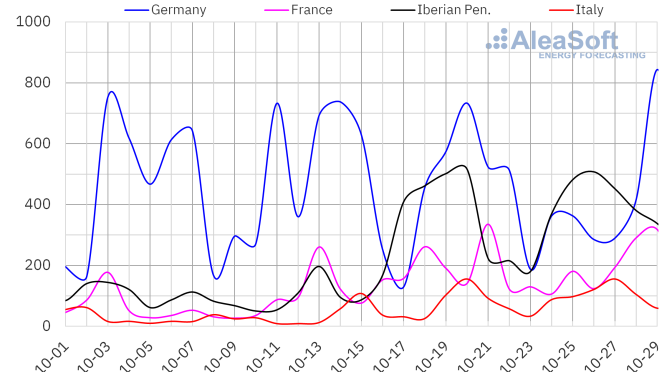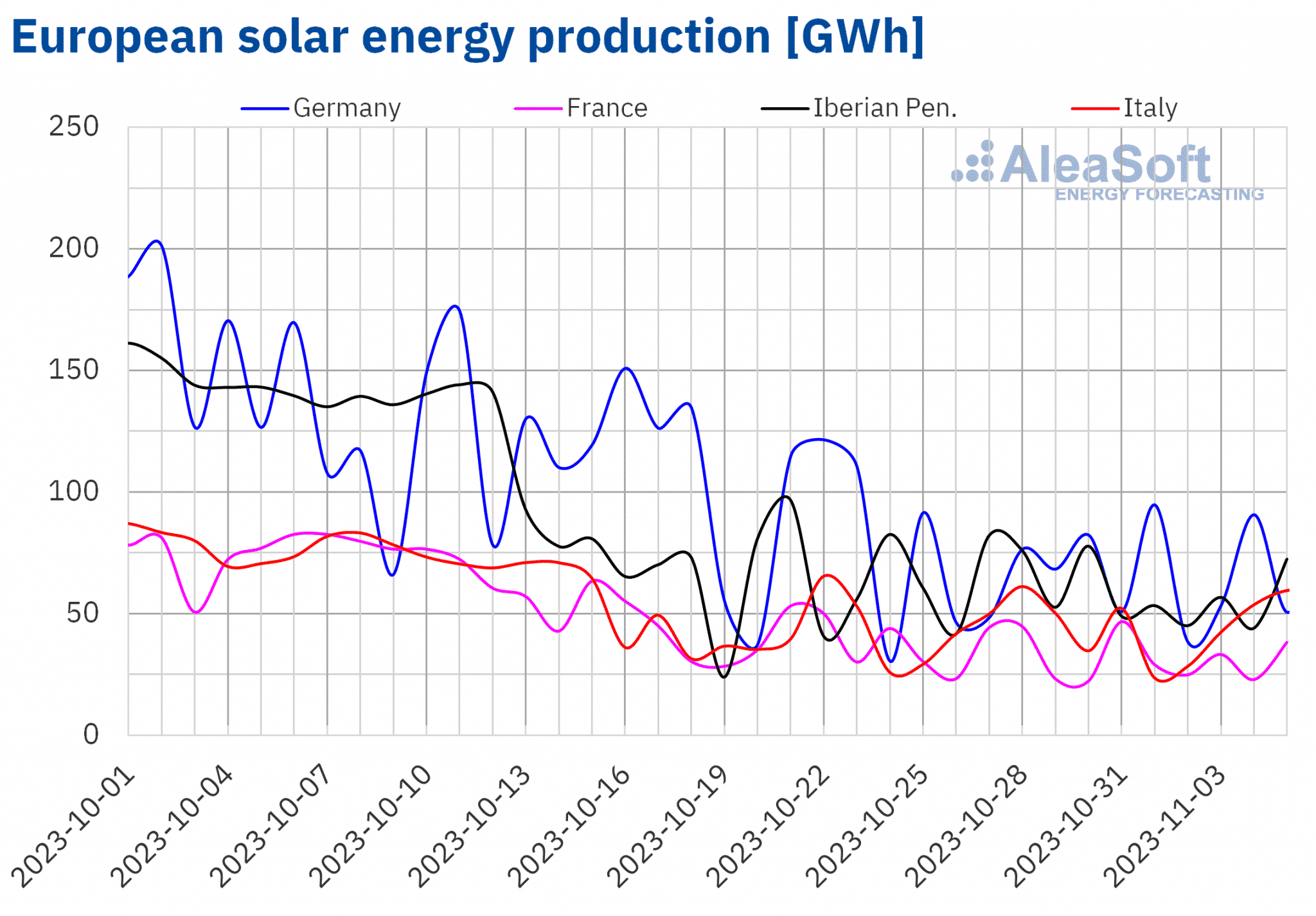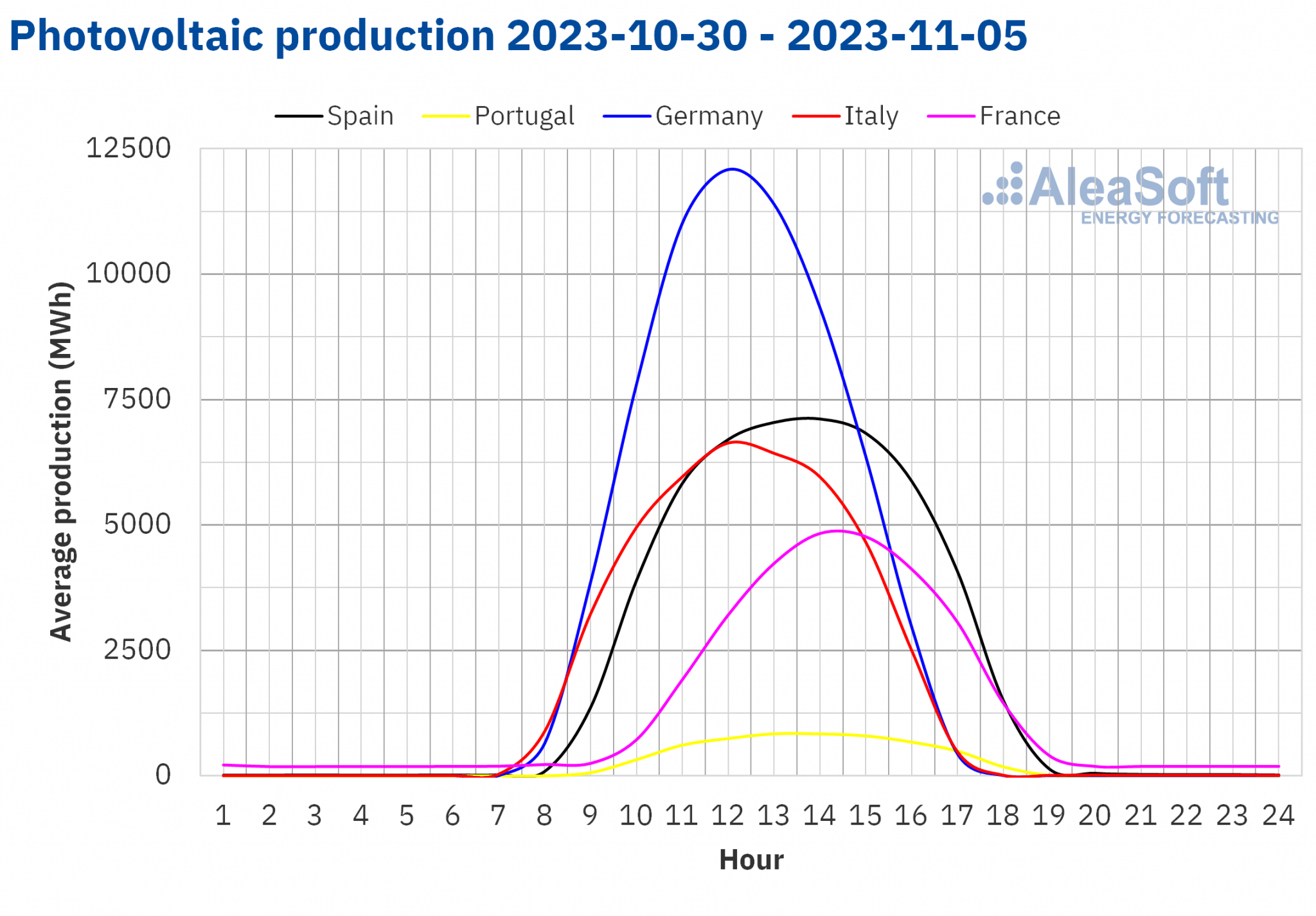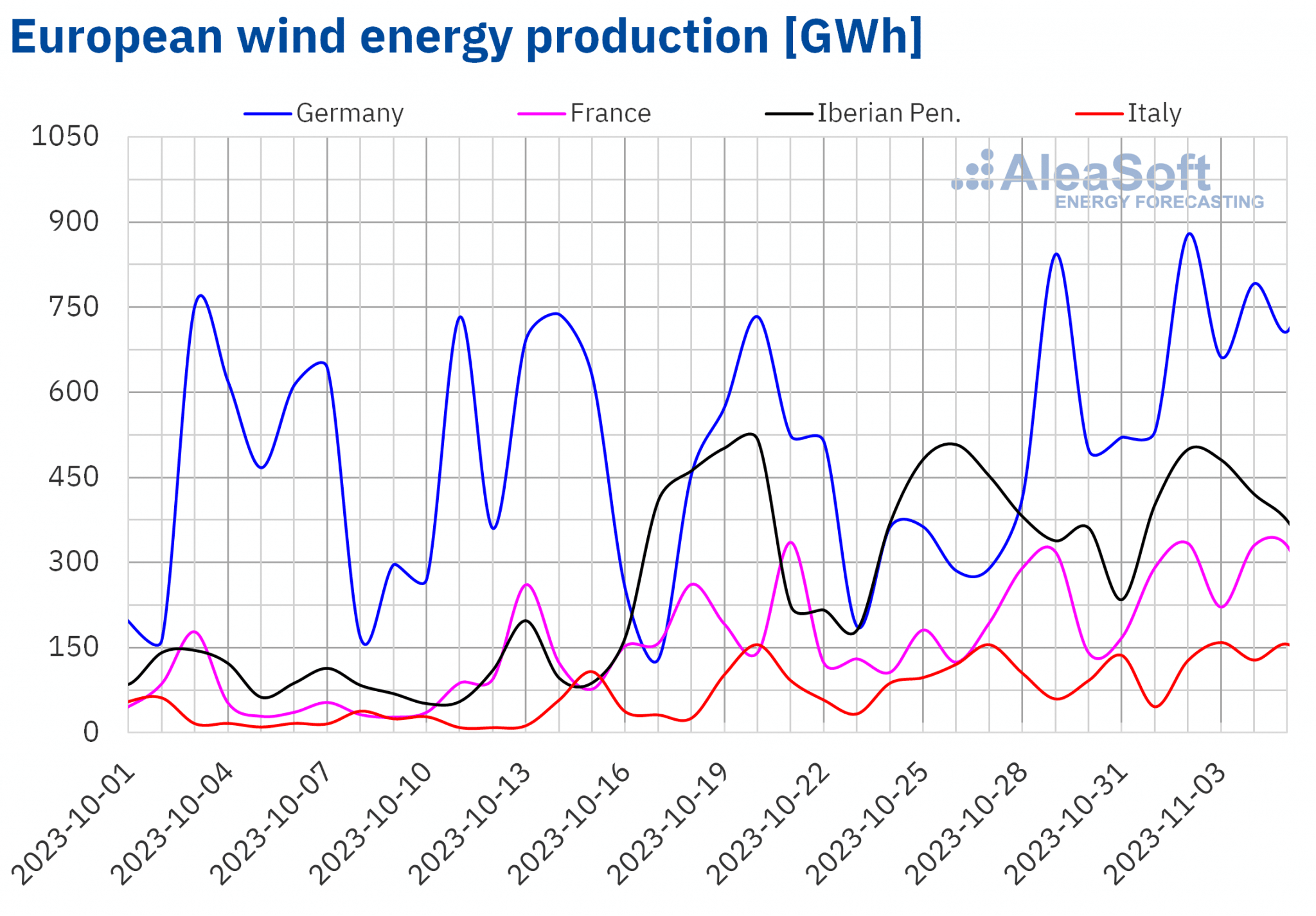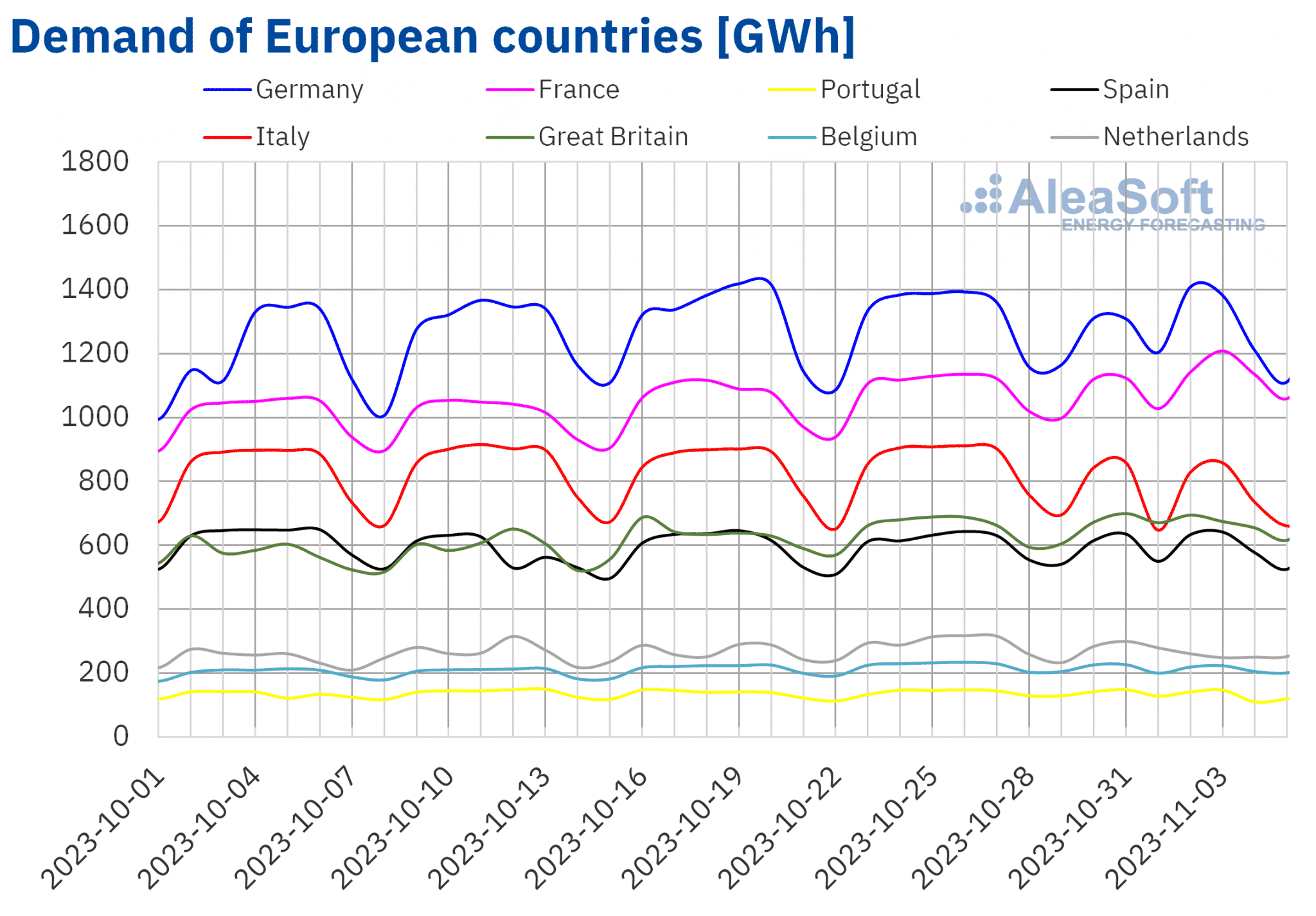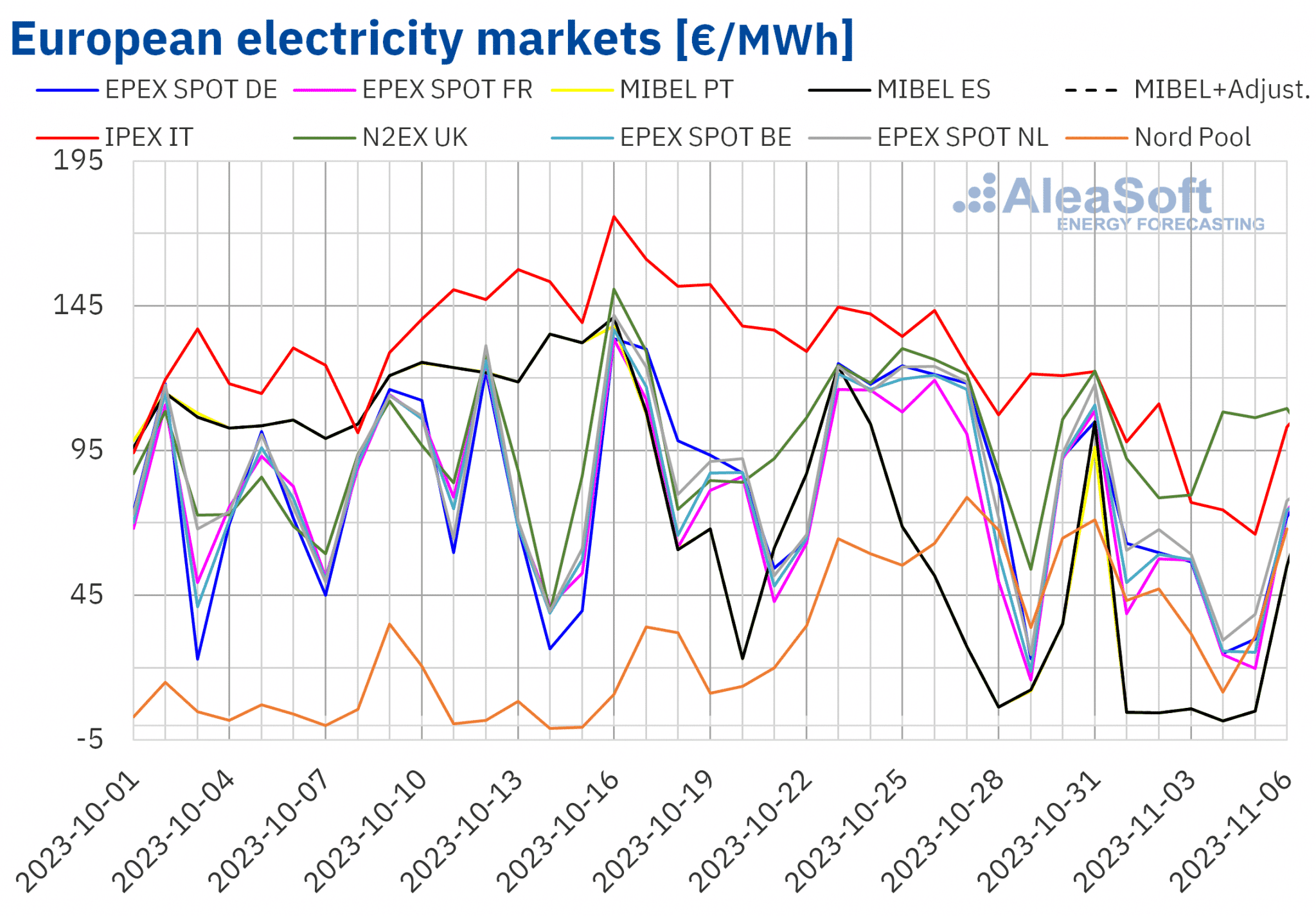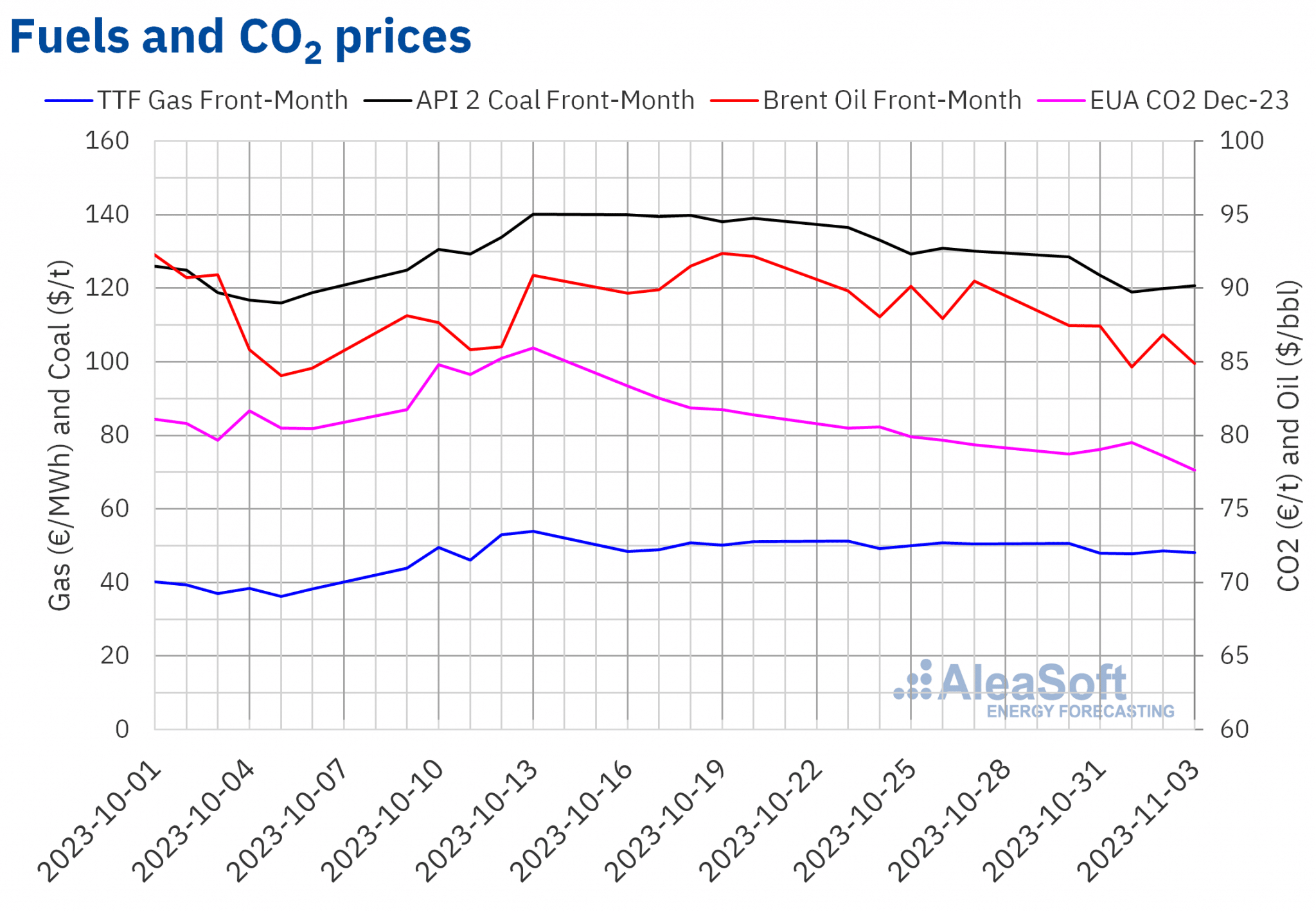In the first week of November, wind energy production reached a weekly record in Italy and in Portugal it was the second highest in history. In addition, almost all markets registered an increase in production using this technology. This, together with lower demand and lower gas prices, contributed to a downward trend in European electricity market prices. From October 26 to November 6, the MIBEL market had the lowest prices, with the exception of the 31st.
Solar photovoltaic, solar thermoelectric and wind energy production
In the week of October 30, most major European markets registered a decrease in solar energy production from the previous week. This is not surprising as the fall progresses and the days get shorter. In the Spanish market, solar energy production had the largest drop, 14%. In the German market, production using this renewable technology registered the smallest decline, 2.4%. As in the previous week, the exception was the Portuguese market, where solar energy production increased by 8.6%. According to forecasts of AleaSoft Energy Forecasting, solar energy production will increase in Germany, Spain and Italy in the week of November 6.
Source: Prepared by AleaSoft Energy Forecasting using data from ENTSO-E, RTE, REN, REE and TERNA.
Source: Prepared by AleaSoft Energy Forecasting using data from ENTSO-E, RTE, REN, REE and TERNA.
Wind energy production offset the drop in solar energy production. The week of October 30 brought an increase in wind energy generation compared to the previous week in all major European markets. The exception was Spain, where wind energy production was high, although there was virtually no change in the weekly total compared to the previous week. In the German market, wind energy generation registered the largest increase, which was 67%. The Portuguese market had the smallest increase, 12%. The Italian market set an all?time record for weekly wind energy production by generating 846 GWh using this technology during the first week of November. The Portuguese market ended the week with a wind energy generation of 567 GWh, being the second highest value after the record production in the week of February 8, 2016, which was 587 GWh.
According to AleaSoft Energy Forecasting’s wind energy production forecasts, wind energy production will decrease in all analyzed markets in the week of November 6.
Source: Prepared by AleaSoft Energy Forecasting using data from ENTSO-E, RTE, REN, REE and TERNA.
Electricity demand
In the week of October 30, most major European markets registered a decrease in electricity demand compared to the previous week. The celebration of All Saints’ Day, on November 1, in most of Europe contributed to these declines. The Italian market registered the largest drop, 8.5%. The Spanish market saw the smallest decline, 1.2%. Only France and Great Britain registered an increase in electricity demand, 2.5% and 2.2%, respectively. Great Britain did not celebrate All Saints’ Day.
During the same period, average temperatures decreased in all analyzed markets, except in the Netherlands. The decreases ranged from 2.0 °C in France to 0.5 °C in Belgium.
According to AleaSoft Energy Forecasting’s demand forecasts, demand will increase in all analyzed markets in the week of November 6 compared to the previous week.
Source: Prepared by AleaSoft Energy Forecasting using data from ENTSO-E, RTE, REN, REE, TERNA, National Grid and ELIA.
European electricity markets
In the week of October 30, the main European electricity markets registered a downward trend in prices compared to the previous week. The MIBEL market of Spain and Portugal reached the largest price declines, 59% and 61%, respectively. In contrast, the N2EX market of the United Kingdom registered the smallest drop, 9.1%. In the other markets, prices falls ranged from 27% in the IPEX market of Italy to 39% in the EPEX SPOT market of Germany.
In the first week of November, most analyzed European electricity markets had weekly averages below €70/MWh. The exceptions were the Italian and British markets, where prices averaged €95.72/MWh and €99.08/MWh, respectively. In contrast, the Portuguese and Spanish markets registered the lowest average prices, €21.77/MWh and €23.02/MWh, respectively. In the rest of analyzed markets, prices ranged from €42.87/MWh in the Nord Pool market of the Nordic countries to €66.77/MWh in the Dutch market.
In the first week of November, the MIBEL market reached the lowest hourly prices. From November 3 to 5, this market registered nineteen hours with a price of €0.00/MWh. The Italian market registered a minimum hourly price of €2.46/MWh. This price, registered on November 5 from 14:00 to 15:00, was the lowest since May in Italy. On the other hand, on Monday, November 6, from 18:00 to 19:00, the Nordic market reached the highest price since April, €142.69/MWh.
On the other hand, from October 26 to November 6, the MIBEL market had the lowest daily prices among the main European markets, with the exception of October 31.
During the week of October 30, the fall in the average price of gas and CO2 emission rights, the decline in demand in most markets and the increase in wind energy production led to lower prices in European electricity markets. In the case of the Portuguese market, solar energy production also increased. This contributed to Portugal registering the lowest weekly average. According to AleaSoft Energy Forecasting’s price forecasts, in the second week of November prices will increase in most European electricity markets analyzed. The increase in demand and the decrease in wind energy production will influence this behavior.
Source: Prepared by AleaSoft Energy Forecasting using data from OMIE, EPEX SPOT, Nord Pool and GME.
Brent, fuels and CO2
On Monday, October 30, in the ICE market, Brent oil futures for the Front?Month registered their weekly maximum settlement price, $87.45/bbl, although this price was 2.6% lower than the previous Monday. On the other hand, on Wednesday, November 1, they registered their weekly minimum settlement price, at $84.63/bbl. This price was 6.1% lower than the previous Wednesday. Despite recovering slightly on Thursday, in the last session of the first week of November, the settlement price fell below $85/bbl again, reaching $84.89/bbl. This price was 6.2% lower than the previous Friday.
During the first week of November, diminishing fears that the conflict in the Middle East would affect supply helped prices to fall. At the beginning of the second week of November, confirmation that Russia and Saudi Arabia will maintain their planned production cuts until the end of 2023 influenced Brent oil futures prices upwards.
As for TTF gas futures in the ICE market for the Front?Month, on Monday, October 30, settlement prices reached their weekly maximum, reaching €50.55/MWh. For the rest of the week, settlement prices remained below €50/MWh. On November 1, settlement prices reached their weekly minimum, €47.76/MWh. This price was 4.3% lower than the previous Wednesday.
Higher than usual temperatures for the season and high levels of European reserves kept prices below €50/MWh in the first week of November. In addition, Israel resumed its gas exports to Egypt, which also exerted a downward influence on prices. Settlement prices of CO2 emission rights futures in the EEX market for the reference contract of December 2023 remained below €80/t during the first week of November. On Wednesday, November 1, these futures reached their weekly maximum settlement price, reaching €79.51/t. However, prices declined on Thursday and Friday. As a result, the settlement price on Friday, November 3, reached the weekly minimum, €77.65/t. This price was 2.1% lower than the same day of the previous week and the lowest since mid?January.
Source: Prepared by AleaSoft Energy Forecasting using data from ICE and EEX.
AleaSoft Energy Forecasting’s analysis on the prospects for energy markets in Europe and the energy transtion
AleaSoft Energy Forecasting and AleaGreen are organizing the next webinar in their monthly webinar series for Thursday, November 16. Luis Marquina de Soto, President of AEPIBAL, the Business Association of Batteries and Energy Storage, will be the guest speaker at this webinar. The main topics to be discussed in the webinar include the prospects for European energy markets for the winter 2023?2024 and the vision of the future for batteries and energy storage.
